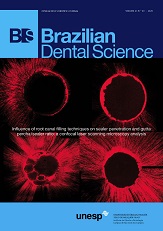Study of the pterigidal canal (vidian canal) through images of cone beam computer tomography.
DOI:
https://doi.org/10.14295/bds.2020.v23i3.1966Abstract
Objective: The aim of this study was to evaluate the pterygoid canal (PC) by Cone Beam Computed Tomography (CBCT), establishing its configuration and proximity with anatomical structures. Material and Methods: We evaluated 398 CBCT exams, all from a public University radiology clinic archive. Four parameters were evaluated: single or double PC, distance between PC and the inferior part of the sphenoid sinus (SS), ratio of PC and SS and the distance between the PC and the foramen rotundum. Results: It was observed that most of the PC of the sample presented simple morphology, the most frequent type of relationship between the PC and the SS on both sides was the close contact with the wall. Among the cases that there were some distances between the PC and the inferior wall of the SS, the mean of this distance did not exceed 3.20 mm, being the left side (3.03 mm) slightly closer than the right (3.20 mm). Finally, the distances between the PC and the corresponding Foramen Rotundum are presented with mean values of 5.87 mm for the right side and 6.31 mm for the left side. Conclusion: CBCT examination is of paramount importance for PC identification; once in the studied sample, the mean values found evidence the close relation between the PC and the SS.
Keywords
Cone beam computed tomography; Endonasal approach; Vidian canal.
Downloads
References
Yazar F, Cankal F, Haholu A, Kiliç C, Tekdemir I. CT evaluation of the vidian canal
localization. Clin Anat. 2007;20(7):751–754. doi:10.1002/ca.20496.
Hamid O, El Fiky L, Hassan O, Kotb A, El Fiky S. Anatomic variations of the
sphenoid sinus and their impact on trans-sphenoid pituitary surgery. Skull Base.
;18(1):9–15. doi:10.1055/s-2007-992764.
Mohebbi A, Rajaeih S, Safdarian M, Omidian P. The sphenoid sinus, foramen
rotundum and vidian canal: a radiological study of anatomical relationships. Braz J
Otorhinolaryngol. 2017;83(4):381–7.
Rahmati A, Ghafari R, AnjomShoa M. Normal variations of sphenoid sinus and the adjacent structures detected in cone beam computed tomography. J Dent (Shiraz). 2016;17(1):32–7.
Yamasaki A, Sedaghat AR, Lin GC, Curry WT, Shih HA, Gray ST. a rare finding of schwannoma of the vidian canal: a case report. J Neurol Surg Rep.
;76(1):e48–e51. doi:10.1055/s-0034-1544112.
Bahşi İ, Orhan M, Kervancıoğlu P, Yalçın ED. The anatomical and radiological
evaluation of the Vidian canal on cone-beam computed tomography images. Eur Arch Otorhinolaryngol. 2019;276(5):1373–83. doi:10.1007/s00405-019-05335-6.
Kurt MH, Bozkurt P, Bilecenoğlu B, Kolsuz ME, Orhan K. Morphometric analysis of vidian canal and its relations with surrounding anatomic structures by using cone beam computed tomography [published online ahead of print, 2019 Aug 26]. Folia Morphol (Warsz). doi:10.5603/FM.a2019.0094.
Inal M, Muluk NB, Arikan OK, Şahin S. Is There a Relationship Between Optic
Canal, Foramen Rotundum, and Vidian Canal?. J Craniofac Surg. 2015;26(4):1382–88. doi:10.1097/SCS.0000000000001597.
Inal M, Muluk NB, Arikan OK, Şahin S. Is There a Relationship Between Optic Canal, Foramen Rotundum, and Vidian Canal?. J Craniofac Surg. 2015;26(4):1382–88. doi:10.1097/SCS.0000000000001597
Klokkevold PR. Cone beam computed tomography for the dental implant patient. J Calif Dent Assoc. 2015;43(9):521–30.
Kamburoğlu K. Use of dentomaxillofacial cone beam computed tomography in dentistry. World J Radiol. 2015;7(6):128–30. doi:10.4329/wjr.v7.i6.128
Yeğin Y, Çelik M, Altıntaş A, Şimşek BM, Olgun B, Kayhan FT. Vidian canal types and dehiscence of the bony roof of the canal: an anatomical study. Turk Arch Otorhinolaryngol. 2017;55(1):22–6. doi:10.5152/tao.2017.2038
Yeh IK, Wu IS. Computed tomography evaluation of the sphenoid sinus and the vidian canal. B-ENT. 2013;9(2):117–21.
Mason EC, Hudgins PA, Pradilla G, Oyesiku NM, Solares CA. Radiographic analysis of the vidian canal and its utility in petrous internal carotid artery localization. Oper Neurosurg (Hagerstown). 2018;15(5):577–83. doi:10.1093/ons/opx305.
Castelnuovo P, Nicolai P, Turri-Zanoni M, Battaglia P, Bolzoni Villaret A, Gallo S, et al. Endoscopic endonasal nasopharyngectomy in selected cancers. Otolaryngol Head Neck Surg. 2013;149(3):424–30. doi:10.1177/0194599813493073.
Downloads
Additional Files
Published
How to Cite
Issue
Section
License
Brazilian Dental Science uses the Creative Commons (CC-BY 4.0) license, thus preserving the integrity of articles in an open access environment. The journal allows the author to retain publishing rights without restrictions.
=================




























